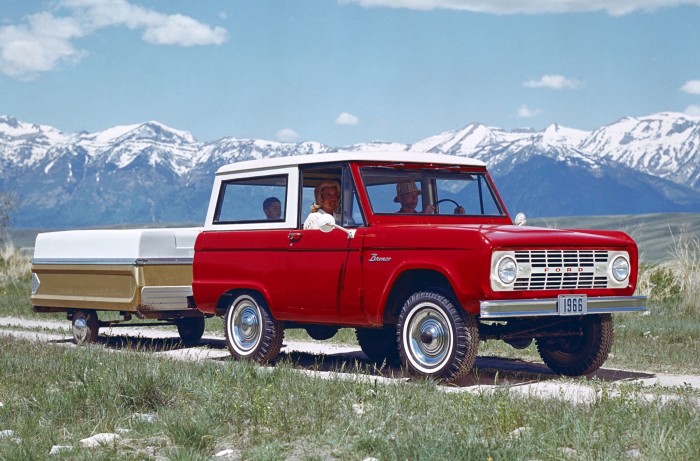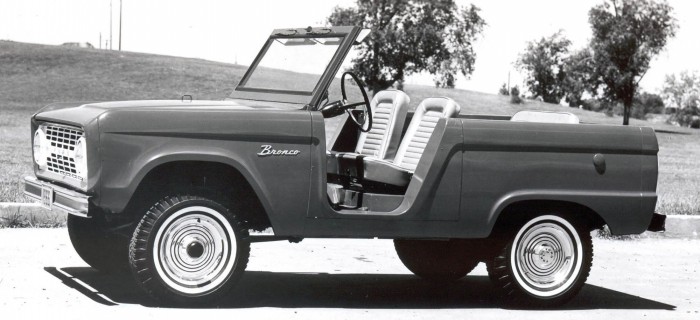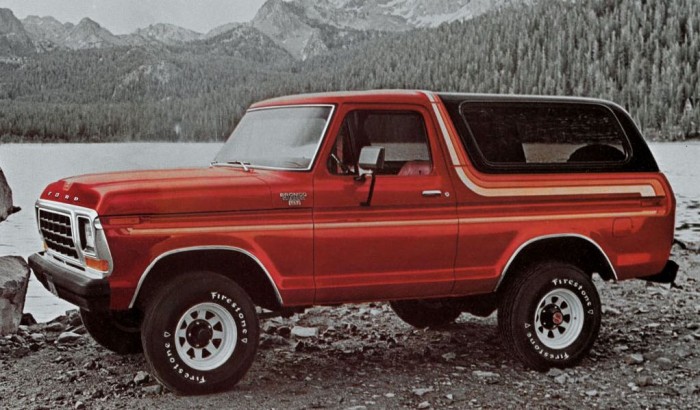Bronco, Ford’s first SUV, turns 50
Posted on Oct 9, 2020 in Featured | 2 comments

Photos courtesy Ford Motor Company, except where noted.
Other manufacturers had pioneered the format before the Bronco. Others had even applied the “sport utility” name to their products before the Bronco. But Ford’s Bronco, when it hit the scene in late 1965, was the first to combine the two and open wide the four-wheeling market—and then later take that market into luxury territory. Starting later this month, a number of celebrations will mark the off-roader’s upcoming 50th anniversary.
When Ford introduced the Bronco on October 1, 1965, it did everything in its power to tie the trucklet to the Mustang, hoping to capitalize on the pony car’s incredible success. Ford’s ads described the Bronco as the Mustang’s stablemate and called the Bronco “a new kind of sports car with four-wheel drive.” Of course, Ford’s ad copywriters weren’t the first to explore that territory—Enzo Ferrari famously described the Willys Jeep as America’s only true sports car—but the approach worked: Ford sold more than 22,000 Broncos in their first model year, at a time when the entire four-wheel-drive market in the United States didn’t consist of much more than that amount.

For its first year, the Bronco consisted of three models: the U-130 Roadster, which came without a top or doors and with molded fiberglass inserts in the place of the latter; the U-140 Sport Utility, which came with a steel half-cab top and doors that transformed the Bronco into a pickup; and the U-150 Station Wagon, which came with a full steel top and doors. The off-roader also initially came with just one engine—the 105hp 170-cu.in. straight-six—which sent power through a three-speed manual transmission and two-speed transfer case to the coil-sprung Dana 30 front and leaf-sprung Ford rear axles. By May of 1966, Ford made the 289-cu.in. V-8 optional in the Bronco.
As Paul McLaughlin noted in his Ford Bronco: An Illustrated History, Ford took a page from its Mustang playbook and offered plenty of extra-cost options “so that Bronco owners could tailor-make a vehicle that best fit their needs.” As with Ford’s cars, the option list included a number of convenience and dress-up items—pinstriping, lighter, horns, AM radio—but the option list went much further with such accessories as a plowing package, grille guard, fire extinguisher, PTO, and a tarp and compass.
While GM answered the Bronco with its bigger Blazer/Jimmy twins in 1969, Ford kept the Bronco small—comparable to the Jeep CJ series or the International Scout—through to 1977. However, the list of standard and optional items grew more luxurious and less utilitarian. By the mid-Seventies, as McLaughlin noted, standard equipment on the base model included a padded dash, sun visors, two-speed electric wipers, and even the 302-cu.in. V-8, while the upgraded Bronco Explorer and Bronco Ranger trim levels added headliners, chrome trim and carpets.

Image courtesy OldCarBrochures.com.
The switch to a full-size Bronco, one based on the full-size trucks and better geared to take on the Blazer/Jimmy, came in 1978. Ford’s press materials noted that the bigger Bronco would “better provide the roominess, comfort, and convenience demanded by today’s 4×4 buyer.” The smaller Ranger-based Bronco II would come along in 1984 to fill the small SUV segment that the Bronco vacated, and while both the Bronco and Bronco II lasted into the 1990s (the latter until 1990, the former until 1996), they increasingly catered to luxury buyers with power accessories and Eddie Bauer trim packages.





.gif)


I had a STROP Bronco that I bought from Sun Valley Ford in Concord CA. I drove it to Ensanada for the Baja 1000 and met Bill Strop and had him autograph the dash. If anybody knows where it is I would like to know. Might even like to buy it back.
You can find a bunch of info on these on the net (apparently one of 650) but you need to use the correct spelling “Stroppe” not “Strop”. Bill Stroppe was the mad-genius behind the “Big Oly” Bronco that was a fixture on the off-road circuit in the early 70s, more of a tube framed funny car going out for Halloween as a Bronco than a modified Ford.